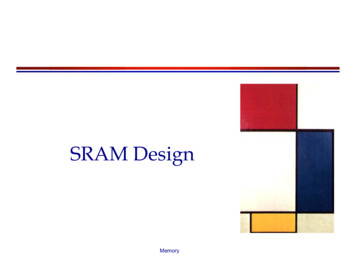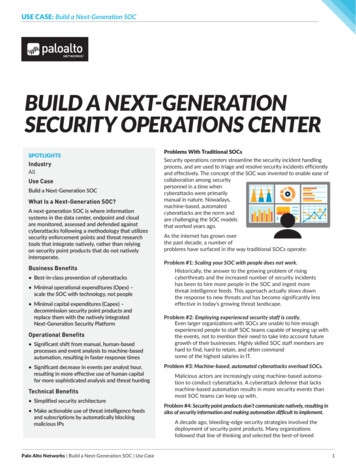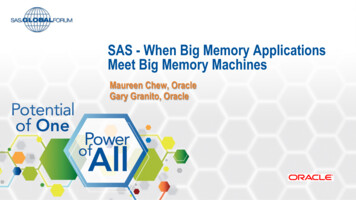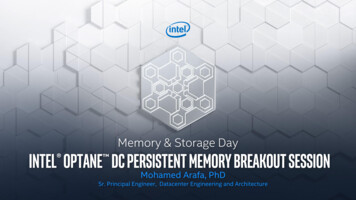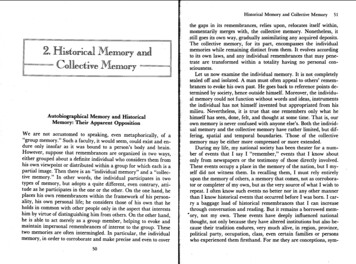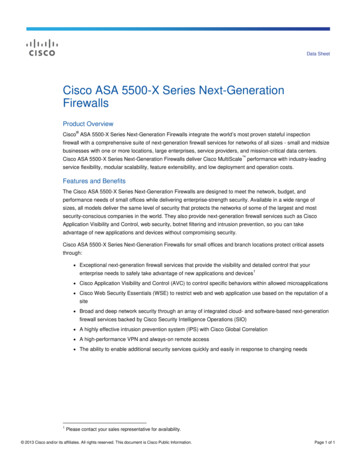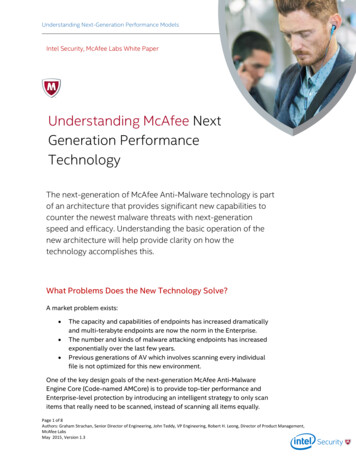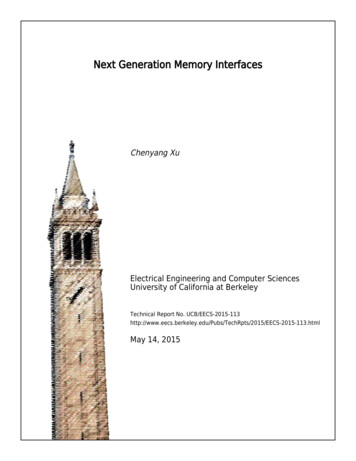
Transcription
Next Generation Memory InterfacesChenyang XuElectrical Engineering and Computer SciencesUniversity of California at BerkeleyTechnical Report No. /TechRpts/2015/EECS-2015-113.htmlMay 14, 2015
Copyright 2015, by the author(s).All rights reserved.Permission to make digital or hard copies of all or part of this work forpersonal or classroom use is granted without fee provided that copies arenot made or distributed for profit or commercial advantage and thatcopies bear this notice and the full citation on the first page. To copyotherwise, to republish, to post on servers or to redistribute to lists,requires prior specific permission.AcknowledgementProfessor Alon EladProfessor Stojanovic Vladimir
University of California, Berkeley College of EngineeringMASTER OF ENGINEERING - SPRING 2015EECSIntegrated CircuitNext Generation Memory InterfacesChenyang XuThis Masters Project Paper fulfills the Master of Engineering degreerequirement.Approved by:1. Capstone Project Advisor:Signature: DatePrint Name/Department:2. Faculty Committee Member #2:Signature: DatePrint Name/Department:
AbstractAs DDR memory technology has increased its pace transferring from DDR3 toDDR4, the design of the physical layer complying DDR4 JEDEC has become essential tomemory controller overall performance. This work presents the design of the transmitterblock implementation inside the physical layer of the memory controller running with3.2GHz. Detailed design have been analyzed for implementing the transmitter which isable to provide adjustable matched impedance with transmission line and meanwhilehaving the output swing complying the DDR4 JEDEC specification. Two impedance linemodels was used in the simulation. This work also conducts a comprehensive research ofthe current DDR4 technology in the aspect of industry trend, potential market size,potential customers, competitive technologies and intellectual property issues.
Next-Generation Memory Interfaces Capstone ReportChenyang XuMay 15th, 2015
1Table of ContentsProject Context and IntroductionIndustry, Market, and Trends AnalysisIP StrategyTechnical Contribution: TransmitterConclusion and ReflectionBibliography2316203436
2Project Context and IntroductionAs a team we designed and tested the physical interface (PHY) for DDR4 memory.Our PHY design is to be used by the Berkeley Wireless Research Center (BWRC) in futureresearch projects. The PHY is an essential circuit block that facilitates the communicationbetween a memory controller and the DDR4 memory itself. Figure 1 illustrates where thePHY exists in a typical computer’s data flow.Figure 1. Simplified flow diagram of data between the processor and memory in a typicalcomputer system.DDR4 is the latest generation of high-speed Dynamic Random Access Memory(DRAM). DRAM is used widely in nearly every modern computer system includinglaptops, desktops, smartphones, and servers. DDR4 is faster and more energy efficient thanit’s predecessors, and it’s crucial that BWRC leverage this technology in their research.Our PHY block is an integral part in enabling the use of DDR4.The PHY has been divided into five separate circuit blocks, two digital blocks andthree analog blocks. The digital blocks have been designed and verified through place androute. The analog blocks have been modeled in VerilogA and circuits have been designedthat fit these models. Furthermore, we designed the circuits using an educational32nm/28nm technology. As such, we have not designed the PHY to tape-out and it will not
3be manufactured. However, the IP (Verilog source code and circuits) are provided toBWRC so that they are able to develop the circuits in a usable technology if desired.We’ve integrated all blocks into Cadance as individual circuit blocks and wrappedthem in a top-level test infrastructure to verify that all blocks communicate properly withone another. For more information regarding the different circuit blocks, see the TechnicalContribution section of this isforthesemiconductor/memory industry, an IP strategy including the possibility for a patent, andmy personal technical contributions to the project.Industry, Market and Trends AnalysisIn this section we will investigate the current semiconductor industry, whattechnologies exist and how our technology fits, and elaborate on the current competitivelandscape of the market. We will also establish our possible clients, stakeholders, and ourgo-to-market strategy. Finally, we will evaluate the current social, technological, andeconomic trends and how these forces affect the industry.Integrated circuits are an important sector in the semiconductor industry. Thesemiconductor industry is known to be highly competitive in nature, and the trend has beenincreasing over the years (Ulama 2014:19). Product life cycles are short, as moretechnologically advanced products replace older ones. Adoption of products is majorlyaffected by performance and reliability. The notable companies in the integrated circuitsindustry are Intel Corporation and Samsung Electronics with 7.6% and 5.3% of the globalsemiconductor and electronics parts manufacturing market, respectively (IBISWorld 2015:
427). Broadcom Corporation, Texas Instruments Inc., Advanced Micro Devices (AMD) Inc.,Micron Technology Inc. are a few of the other major companies that compete in thisindustry (Ulama 2014:19). The major companies in this industry are all fairly large andwell established, and compete over products and technologies. High demand for productsand extremely low pricing intensify the competition in the industry. This poses a significantbarrier to entry for new and smaller companies leading to only several companies currentlybuilding DDR4 memory chips and controllers. In fact, Micron and Samsung is the onlyone of the large integrated circuits companies listed above that develops DRAMtechnology.As we strive to make a smaller, faster, and more efficient memory interface, wehave to compete with the products, research and development efforts of competingcompanies. Our competitive landscape does not merely include semiconductor companies,but also technologies that have similar features and functions when compared against ourproject. Existing memory technologies, such as DDR3, 3D stacked (3DS) - DDR3, andGDDR4, compete with DDR4 on various parameters such as cost, speed, and use-cases.While DDR4 is faster than previous memory generations, the higher cost of the new chiptechnology would make the cheaper DDR3 technology a strong competitor.Emphasis is placed on the significant performance improvements that DDR4presents over DDR3 technology. The following table shows a brief comparison of the keyfeatures between two technologies.Table1. Comparison between DDR3 and DDR4 [1]:DDR3Power supply voltage 1.5VDDR41.2 V
5Speed1.6 2.1 Gbps 1.6 3.2 GbpsDensity8GB(max)16GB(max)Price 100 avg 200 avg.The first comparison is in regards to power efficiency, not only does DDR4 have alower supply voltage, but it also implements a new algorithm to control its energyconsumption by entering its “standby” mode more frequently and precisely than DDR3.The improvements lead to better performance in both the power consumption, andoperating temperature.Furthermore, the most essential feature, memory speed, has been improvedsignificantly in DDR4. The analogy between the memory speed and highway traffic speedis very descriptive. The speed of the memory is the amount of data can be transferred in acertain period of time. There are two factors determining the speed, which are, interfacewidth and frequency of the memory’s operation. Considering the analogy, the bandwidthis the quantity of lanes on a highway, and frequency is the travel speed of its vehicles.Within a fixed time period, having more lines and a faster speeds will allow for morevehicles to travel. Similarly, having an improved working frequency, along with anenlarged bandwidth, DDR4 achieves a data transmission speed that is approximately 1.5times faster than DDR3, as Table 1 indicates. The increase of the speed is benefited fromthe revolutionary bank-group management technology.Another differentiating factor is the density, or say, the space of a single memory chip.Advancements in the chip’s encapsulation provide DDR4 a 50% density increase, withregard to maximum space. With a larger storage space, DDR4 is able to process moreinformation simultaneously. However, similar to every emerging new technology, the
6current price of DDR4 memory is 30% to 50% more expensive than DDR3, which canachieve similar functionality at lower speeds. With a large-scale adaptation for DDR4memory, and hardware compatibility of its peripheral devices, the manufacture price wouldquickly become more affordable in the future.GDDR3 and GDDR5, which stand for Graphics Double Data Rate, are a kind ofmemory specifically designed for image processing. Despite the similarity in terms of thename, the graphic memory is named one generation ahead regular memory. This meansthat the core technology of GDDR3 is essentially an upgraded version based on DDR2technology, rather than DDR3. The graphic memory is designed to have lower energyconsumption, and an optimized performance when dealing with graphical-dataprocessing. Since the application area of these two kinds memory differentiates amongsteach other, they do not compete directly. The Graphic DDR is typically developed basedon the previous generation of DDR memory technology, with improvements on speed aandapplication-specific functional modifications.As for the market analysis of our product, the main markets include traditionalmemory devices and consumer electronics - and they are booming. Based on transparencymarket research, it states that the global next generation memory technologies market wasworth 207.8 million in 2012, and is projected to be worth 2,837.0 million by 2019,growing at a 46.1% average growth rate from 2013 to 2019 (Transparency MarketResearch, 2014). The report divides the overall market for next generation memorytechnologies on the basis of certain parameters: interface type, application, and geography.On the basis of interface, the market for next generation memory technologies can becategorized into SATA, SAS, DDR, and PCIe and I2C (Transparency Market Research,
72014). The main applications of next generation memory technologies include embeddedMCU and smart card, mobile phones, mass storage, cache memory, enterprise storage, andautomotive.Geographically, the global next generation memory technologies’ markets can bedivided into North America, Europe, Asia-Pacific, and the rest of the world. This industryis always looking for ways to decrease power consumption, increase density, and developclever architectures. The new generation memory technologies market has gainedsignificant momentum in recent years due to growing demand for faster, highly scalable,and cost-effective memory solutions.Understanding the necessity of our effort follows from understanding the industrydynamic, which our product tempts to enter. After understanding the landscape withinwhich we stand, we remain to have reason to believe that our project is valuable to ourstakeholders. We remain to reason that our stakeholders should be more interested inreceiving a completed deliverable from us over any other, equally qualified, externalcompetitor.Our first differentiating quality is that we offer to provide “non-contracted” work.Contracted work is any work commissioned by one party to be executed by another party.To begin such work, both parties must agree on the terms defined within the agreementdocument prior to the work’s commencement. The agreement is realized through means ofa binding contract that both parties agree to enact. Once the contract is created, it typicallycannot be altered or modified, unless the consent of all parties is evident. This could placethe requesting party into a stiff situation if it discovers that its priorities have changed midway through a contract.
8Upon the project’s completion, the completed work is commonly handed off “asis.” This means that no additional support is to be provided in the future (unless explicitlynegotiated upon within the original contract). Any additional requested support ormodification requires for a new contract to be written. Not only is this financiallyinconvenient, but it can also be logistically inconvenient for the recipient. Without support,the deliverable is handed off with a decreased utility. The recipient of the deliverable isstuck with using the deliverable solely within its original scope.Our stakeholder, BWRC, benefits from ownership over the development process.A common clause added to most contractual work instills a limit on interim designmodification requests. This clause exists to prevent the requesting party from overexertingthe contracted party without compensation. Internal control over the developmentalprocess allows for precise design-source malleability during development, and fullexposure of the design files. Design-source malleability allows for the BWRC professorsto more closely guide our direction through the project’s development. It allows for themto change the path that we follow if new interests arise. There is no contractual overheadto worry about in this scenario.BWRC benefits from retaining access, and owning, the source code and designs.The design-source exposure enables BWRC to question every aspect of the implementationuntil they understand it completely. With contracted work, this information is typicallyunavailable to the requesting party due to trade secrets being used in a design. Owning thesource enables BWRC to have permanent design-source access. Long-term source accessenables cost-effective and effort-effective technology adaptation into any future BWRC
9projects. Along with adaptation, owning the source creates the opportunity for growing inhouse expertise at BWRC through education.The benefits mentioned above align very closely with our stakeholder’s interests.The stakeholder, being BWRC, is interested in three main attributes from the project. First,BWRC wants a fully customizable deliverable due to unpredictable future demands.Second, BWRC wants the freedom to optimize the design for unique implementations thatwould require the modification of the source on a per-use basis. Third, BWRC wants toavoid the financial, temporal, and contractual overheads associated with third-party work.Our project delivers on all three attributes. By choosing to complete this project throughour team, rather than a team of contractors, BWRC satisfies its internal interests.Our team anticipates BWRC’s decision to work with us as opposed to largersuppliers. The current semiconductor marketplace is saturated with both customers andsuppliers. As Ulama describes (Ulama 2014:28), “Established operators in this industryhave been able to develop solid relationships with customers, and it can be extremelydifficult for new companies to gain contracts with customers when existing semiconductormanufacturing operators have built reputations over a long period.” To exemplify thesignificance and the weight carried by the previous statement, note that the Semiconductorand Circuit Manufacturing industry is one of the largest exporting industries in the UnitedStates (Ulama 2014:5). It indirectly provides jobs to 250,000 Americans, is currentlyvalued at 79.5 billion, and has grown at an annual rate of 4.8% (Ulama 2014:5).The current players, both customers and producers, are very well established, andvery tightly connected. Penetrating into the customer base that the massive producerscurrently support is near impossible for a small team like ours due to lack of reputation.
10Aside from penetrating, the customers in this segment of the market are a significantlystrong force due to two reasons: 1. The intrinsic competitiveness of the current suppliers,and 2. “The electronics marketplace is continually under pressure to improve productfunctionality, decrease size, increase speed, and decrease cost.” (IBISWorld GlobalSemiconductor & Electronic Parts 2015:33)Our team has set our target in a completely different direction. Instead of focusingon the massive customers, who are already served very competitively, we direct our focusat an interestingly under-served segment in this market space. In part, our choice ofdirection is due to the methods through which our Capstone project was decided upon. Thedecision process confined the scope of the project to target academic goals and providesolutions for academic institutions. Thus, our customer space currently only encompassesthe Berkeley Wireless Research Center, but is functionally able to serve any academic orsmall-scale organizations.As we currently stand, with one effective customer in our sights, we are subjectingourselves to a very strong customer market force. This is an undesirable outcome due tothe limited size of the space, which we choose to attack, but success in this space will sendpositive signals at other research institutions. We would be able to expand to encompassmore academic institutions because they would prefer to acquire the product through us.Our effective results are comparable to their current methods of operation, but with thebenefit of reduced fixed-cost expenditures – which arise when placing orders with largedesign and manufacture firms.A majority of the market belongs to other companies, most all companies are wellestablish large corporations including Micron (IBISWorld 2015: 27) and Texas
11Instruments (IBISWorld 2015: 30). The barriers that cause this include “access to latesttechnology and intellectual property, the level of investment , access to skilled employees,and the dominance of existing players” (IBISWorld 2015: 25). In the memory industry, thecompanies compete over a very specific set of criteria including price, performance,features and power consumption, all of which are highly measurable and quantifiablemetrics (IBISWorld 2015: 24).If the dimensions of competition between companies in a given industry converge,then the companies are left to compete solely on price (Porter 2008: 12). In the integratedcircuit market, the industry has converged heavily on these metrics of performance,features and power consumption, which has resulted in fierce price competition. Because“economies of scale can be significant in this industry” (IBISWorld 2015: 25), new entrantsmust manufacture large volumes to stand a chance against the bigger companies. Thisrequires up-front capital that many smaller new entrants do not have available. Enteringthe market attempting to compete on these highly competitive dimensions would result in“zero sum competition” (Porter 2008: 13), and and would not be a viable business strategy.When instead of converging on the same dimensions, companies target differentsegments of the customer base, the result can be “positive sum” competition: competitionthat increases the profitability of all companies (Porter 2008: 13). We plan to employ thisstrategy with our DDR4 memory controller. We’ve learned from BWRC that their needsare different than the typical semiconductor customer. BWRC fabricates chips in lowvolumes, so price is not a significant factor. Also, they require only a subset of the industrystandard feature set for DDR4 memory controllers, enabling us to reduce the size of the
12design. Finally, they need very specific portions of the controller designed, not the entireIP block that most competitors would offer.Although the memory technology industry is highly competitive, growing, anddifficult to penetrate, the market is growing fast due to this a demand for consumerelectronics, an industry which is expected to grow 5.3% annually to nearly 300 billiondollars by 2019 (IBISWorld 2014: 4). This high demand and new market bring some spacefor new companies to enter and grow. These new entrants usually emerge during thetransition between the technological revolutions and each one has its own speciality.From the year of 2002 to 2013, DDR memory industry has undergone 4 significanttechnological transitions, all of which are aiming at improving in three performance aspectsand achieving a denser data processing capability. As Darryle stated in the article, theproduct with “high levels of performance, reliability, quality and low levels of powerconsumption” (Bach,2014:6) can gain an apparent advance in the competition of memorydesign industry. Being the three largest manufactures of memory chip and developer ofDDR memory technology, Samsung, Crucial (Micron) and Hynix have already investedmillions of dollars in their R&D sector to develop the new generation DDR4 memoryinterface in order to reinforce their dominating market share.Given such a giant market, other major memory designers such as Kingston keepfastening their pace to catch up the memory controller design for the recent DDR3 to DDR4transition. Besides the companies who are already in the market, there are significantnumber of new companies or say, new entrants, trying to seize this opportunity. Accordingto the statement made by Darryle, “the latest Census data indicates that 64.1% of operatorsin this industry have fewer than 20 employees” (Ulama 2014:25). The development
13strategy of those new entrants are highly focused on certain features, and “specializing ina small number of product lines to serve niche markets” (Ulama 2014:25) in order to avoida direct competition with large companies.Table 2. Representative new entrants in DDR4 memory developmentCompany NameSpecialized market/featureCentury Micro INC.Small physical size & low energy consumptionMontage Technology Fast operating speed & low energy consumptionG.SKILLEnhanced gaming performanceThree unique, representative companies are provided to conduct the analysis of thenew entrant. The table 1 above shows a brief comparison of three distinguished newentrants key product features. It indicates each new entrant is trying to gain its market shareby specializing its product from the three technical aspects mentioned in the previousparagraph.The Japanese based company Century has just halved the physical size of DDR4memory in their most recent product at the year of 2014. The China-based Montage Techis more focusing on developing fast speed and lower power rate DDR4 memory for largescale server use. “Less power draw means less heat and longer battery life”, which indicates“the servers are expected to be the biggest beneficiaries of the jump to DDR4” (Andy,2014:6). Meanwhile, G.SKILL put majority of its resources into developing DDR4memory controller with improved gaming performance. These companies are increasinglysecuring their niche markets by making breakthroughs in design of the memory controllerwhile the major developers are still dominating the memory chip manufacturing area.
14Big companies enjoy economies of scale, making it difficult to compete with themin manufacturing the integrated circuits (ICs). Based on the analysis of the newentrants, in order to build immunity for our design, we plan to segment the market toresearch institutes like BWRC. Their needs are different from most, and provide anopportunity for us to develop a product that satisfies these needs better than the competition.Since the design of our project is specifically for BWRC internal research use, there willbe no direct competition and obvious threat from these new entrants either.The threat from other technologies is weaker, as our DDR4 interface is moreadvanced than existing DDR3/GDDR5 interfaces. Therefore, we focus on developing theintellectual property and targeting the specific needs of the academic communities. Thisspecific category of consumers require more customizable, and open, circuit designs at alower volume, a need that is unmet by the larger companies that package their circuits inblack boxes, manufacture in high volume, and allow little to no customization. Bysegmenting the market based on unmet needs, and our abilities to satisfy them, we hope toentrench our position as a profitable part of the semiconductor industry.From the perspective of semiconductor circuit design, it is a complicated processto design a controller and integrate it with the memory chip. Therefore, our technologysuppliers include both software side and hardware suppliers. Software suppliers are thosewho provide coding languages, design platforms, and simulation tools. Hardware suppliersare those who provide electrical specifications, datasheets, and other fabricationcharacteristics relating to memory chips.Software suppliers mainly provide programming language support. Verilog andSystemVerilog are the two main programming languages we are using. They are hardware
15description languages used to model electronic systems. They are most commonly used indesign and verification of digital circuits. Cadence, a company that provides electronicdesign automation software, covers many language design platforms, including Verilogand SystemVerilog. As an all-in-one suite, Cadence is our main software supplier.Hardware suppliers provide descriptive information about the memory chiptechnology. Our controller is on a software level, but it will be integrated with the nextgeneration memory chip technology, the DDR4 technology. Each generation of memorychips has new fabrication breakthrough. Thus, during our controller design, the latestinformation about memory chips is critical, such as voltage supply of the chips and thememory bank structure. Our hardware suppliers, such as Micron Technology, Intel Corp.,and Samsung, are big semiconductor companies in this industry. In Semiconductor &Circuit Manufacturing in the US Industry Report, Intel Corp. and Samsung have 18% and13.8% market share in 2014 (Ulama 2014:4). Although they seem like our competitorsfrom the sales end, they also have the best research departments and technical experts inthe chip fabrication domain. Samsung competes in the Semiconductor and CircuitManufacturing industry via its fabrication and research and development facilities in theUnited States (Ulama 2014:4). They will release the paper and datasheet of their latestresearch results about DDR4 memory chip. According to the information provided by theselarge semiconductor-manufacturing companies, we are able to define the interface anddesign our memory controller.Powerful suppliers capture more of the value for themselves by charging higherprices, limiting quality or services, or shifting costs to industry participants. As mentionedabove, Intel Corp. and Samsung are both suppliers and competitors for us. If they limit our
16access to their latest technology about DDR4 memory chip, it will be hard for us to competewith them. However, the good news is that the DDR4 memory specification is becoming astandard, so we will be less dependent on them.There are certain aspects that we can focus on to succeed in this capital-intensive,and research-intensive, memory design industry. New companies are trying to explore themarket by boosting their expertise in faster-speed designs, smaller dimension layouts, andhighly customized application-specific designs. WIth increasing maturity of the DDR4technology, the competition is becoming more fierce. This increased competition willlargely benefit the semiconductor industry’s evolution speed, as well as provide customerswith cheaper and higher efficiency devices. Our project will not only encourage furtherdevelopment from competing companies and research groups, but also benefit BWRC’sexploration of the utilization of DDR4’s capabilities.IP StrategyThe PHY interface provides us a good scope for creating a patentable IntellectualProperty. The physical layer has been split into 5 major parts, each of which allow for novelimplementations and innovations in circuit design. As we are working at the cutting edgeof technology, we would have to adopt non-trivial techniques to meet the specifications forhigh data rates of DDR4. One or more of these implementations can provide us patentableIP. This section will discuss why this technology may be patentable, the advantages anddisadvantages of seeking a patent, the current state of the semiconductor IP space, and therisks associated with not seeking a patent.
17In the context of IP, creative designs and creative solutions fall cleanly under thecategory of patentable assets. In essence, the purpose for securing IP is to declarediscernible ownership over a design or utility (USPTO, 2013). As an independent entity,we can draw benefits from securing patents and owning patents. The benefits we pose tosecure range from monetary compensation to strategic industrial presence.From a monetary perspective, owning patents allows our team to claim ownershipto a recognizable asset. After incorporating our team as a legal entity, a patent opens us tothe opportunity of being acquired. The proceeds from an acquisition could be used tofinance additional ventures, which our team currently does not have the financial freedomto pursue.A secondary monetization strategy that patent ownership affords us, is the optionto license our technology to independent entities who wish to avoid committing R&Dexpenses for the purpose of developing said technology independently. Aside from thelegal expense that we would need to undertake, the licensing option is financially robust.The third and final benefit is an unquantifiable benefit. The third benefit arises fromestablishing a reputation as an entity. Acquiring a patent will demonstrate that we, as ateam, know how to drive concepts into patentable ideas, and patentable ideas into awardedpatents. Successfully acquiring a patent will demonstrate to that we are capable as
it's predecessors, and it's crucial that BWRC leverage this technology in their research. Our PHY block is an integral part in enabling the use of DDR4. The PHY has been divided into five separate circuit blocks, two digital blocks and three analog blocks. The digital blocks have been designed and verified through place and route.


